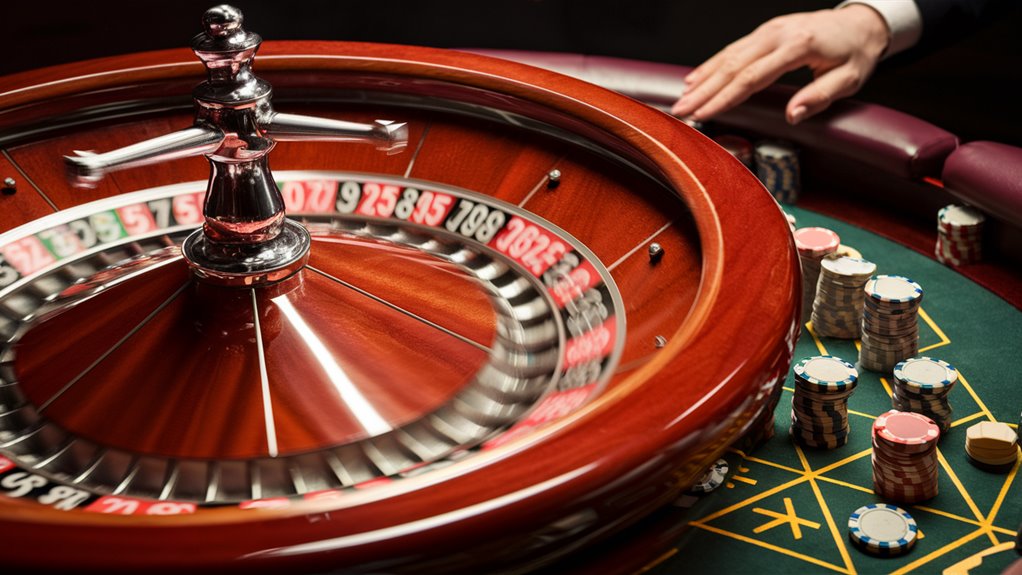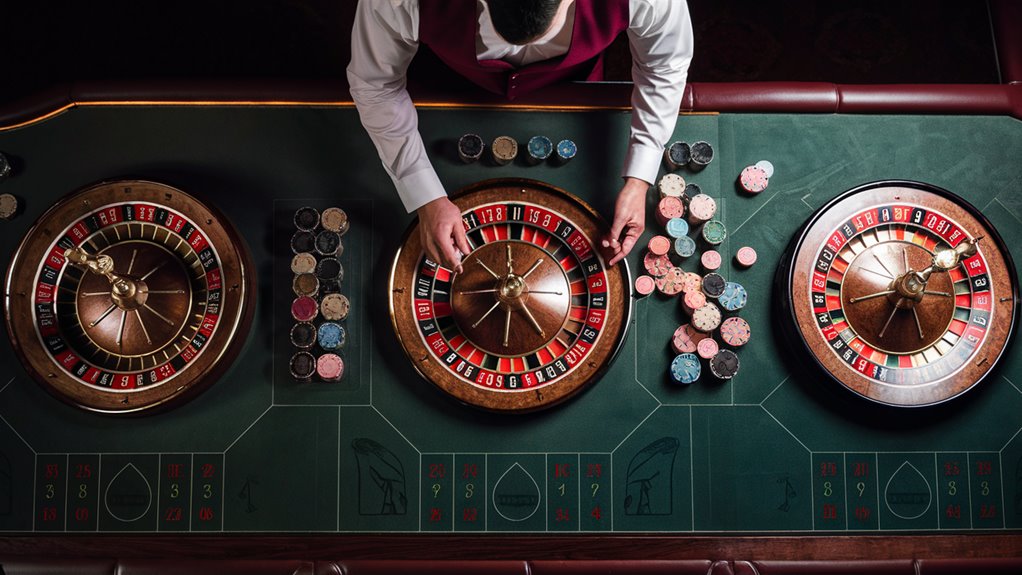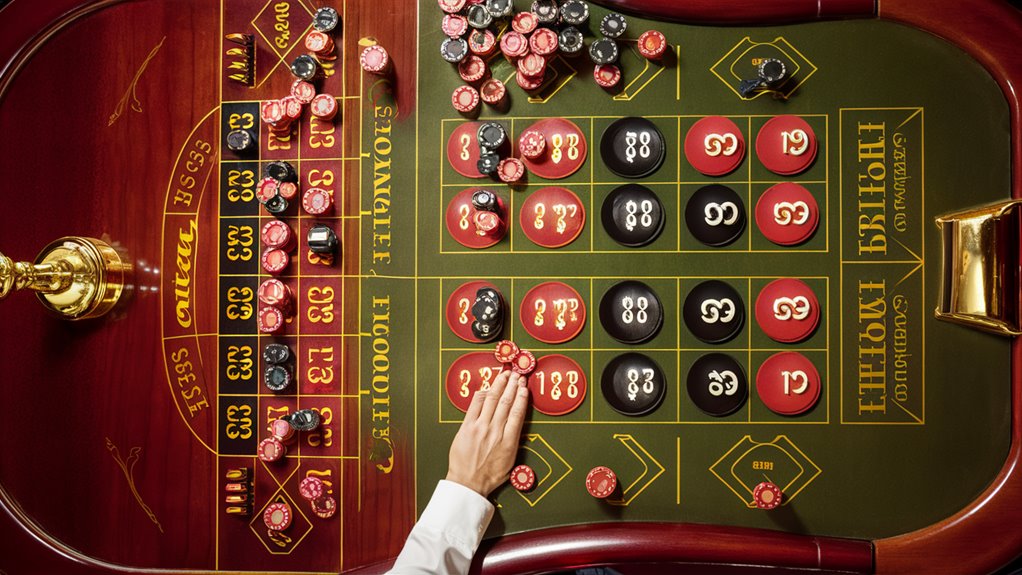
How to Win More at Roulette

Learn Roulette Basics and Odds
Chances are a big part of getting good results in roulette, beyond just banking on luck. Start with European single-zero wheels. They have a tiny house edge of 2.7% compared to American wheels, which have a higher 5.26% house edge.
Top Betting Plans
Pick outside even-money bets as they have a better win chance of 48.6%. Bet on red/black, odd/even, and high/low. Keep your bets at 2-5% of your cash per spin for good money control.
Handle Risk and Know When to Stop
Set strict loss limits at 50% of your starting cash and set win goals of 30% more than you begin with. Watch your hourly loss rate and stop if you reach your limits. This plan keeps your cash safe while aiming for good profits.
Tips for Picking Tables
- Find tables with La Partage or En Prison rules
- Check if the wheel is in good shape
- Watch the dealer habits and betting trends
- Check table minimums and maximums
Keep Your Money Safe
- Keep track of all wins and losses well
- Stay away from progressive bet systems
- Take breaks to stay alert
- Don’t chase losses or bet more than your plan
This plan leans on careful play rather than fast, unsure choices, improving your odds in line with the game’s odds and house edge.
European vs American Roulette: Full Comparison
Main Differences
European roulette and American roulette mainly differ in how their wheels are made.
The European style has a single zero (0) and 37 numbers. American roulette has both a single zero (0) and double zero (00), making a total of 38 numbers. This core difference greatly affects your odds and outcomes.
Edge Analysis
Perks of European Roulette
The house edge in European roulette is just 2.7%, found by splitting the single zero pocket by all slots (1/37). This offers players a better chance to win.
Effect of American Roulette
The added double zero in American roulette brings the house edge to 5.26% (2/38). This almost doubles the casino’s edge, making it hard for players.
Chance Analysis
Clear facts support European roulette’s edge:
- European Roulette: $100 bet on red = $2.70 expected loss per spin
- American Roulette: $100 bet on red = $5.26 expected loss per spin
Over 100 spins, this gap means around $256 more in possible losses on American wheels.
These points show European roulette as a wiser pick for players wanting better odds of winning.
Top Betting Plans: Full Guide
Understanding Casino Bet Plans
Casino bet systems pull in players looking for steady wins. Yet, their success varies widely.
This review digs into well-known betting methods and their number rules.
The Martingale System
The Martingale bet plan is a popular method to try in casinos.
This plan suggests to double your bet after each loss to recover past losses with the next win.
While it seems sound if you have no limit to money and no table caps, real concerns like table limits and limited cash make this method quite risky.
D’Alembert Betting Method
The D’Alembert plan aims for smaller bet changes. In this method, players:
- Bet more by one unit after a loss
- Bet less by one unit after a win
- Keep their cash safer than with Martingale
Even though it’s safer, the D’Alembert can’t beat the house edge.
Fibonacci Betting Plan
The Fibonacci bet plan uses the well-known number sequence (1,1,2,3,5,8…) for adjusting bets. It involves:
- Going back two numbers after a win
- Moving up naturally in the sequence
- Being safer than Martingale
- Still can’t shift the house edges of 2.7% (European) and 5.26% (American)
Limits in Numbers
All bet plans face big odds: they can’t shift the built-in house edge.
While these plans offer a structured way to bet, they still fall under math rules that let casinos win over time.
Money Plans for Roulette Wins

Setting Money Limits
Good money handling is the core of winning at roulette, more vital than any bet plan.
Firm loss limits at 50% of your total cash offer needed protection from major losses.
Clear win goals of 30% help in locking down profits and encouraging smart play. These set rules help you stay level in thrilling game moments.
Right Bet Sizes
Proper bet sizing helps manage swings in luck.
Keep bets within 2-5% of your total cash to endure low moments. This cautious approach keeps you in the game longer and boosts chances for winning moments.
Tracking and Reviewing Bets
Detailed bet tracking lets you make solid, number-based choices on betting ways and results.
Monitor your hourly loss rate well – if losses top 10% of cash per hour, you need to bet less right away.
Understanding that ups and downs in luck are part of roulette, winners focus on long-term play over rapid gains.
Important Risk Tips
- Set clear start and stop points
- Keep strict cash limits
- Stick to fixed bet sizes 카지노사이트 추천
- Follow game numbers closely
- Make needed shifts fast when needed
This planned approach to handling cash secures your bets while aiming for optimal returns in roulette play.
Inside vs Outside Bets in Roulette: Full Strategy Guide
Main Bet Types
Roulette betting strategies divide into two main groups that shape how you play and what you might win.
Inside bets aim at exact numbers or small groups of numbers, offering big wins but with more risk.
Outside bets cover broader groups of numbers, leading to more consistent wins with smaller payouts.
Inside Bets: High Risk, High Potential Wins
Inside betting choices give players high win possibilities.
A straight-up number bet offers a solid 35:1 payout ratio, though only a 2.7% win chance on European wheels Software for full race data
Split bets (17:1) and corner bets (8:1) increase win chances to 5.4% and 10.8% but still carry higher risk.
Outside Bets: Planned, Safe Play
Outside betting strategies provide a secure way to play roulette.
Even-money bets like red/black, odd/even, and high/low offer a steady 48.6% win chance with 1:1 payouts on European wheels.
Column bets and dozen bets have a 32.4% win chance with 2:1 payouts. Blending these outside bets helps handle risks and keeps your cash movements under control.
Numbers and Choosing Strategies
The house edge stays at 2.7% on European wheels no matter the bet, shaping choices mostly around managing swings versus potential wins.
This steady edge allows players to choose based on personal risk level and money management when picking between inside and outside betting methods.
Pro Tips for Choosing Roulette Tables
Key Tips for Best Table Choice
Choosing the best roulette table can greatly impact your expected value and how fun the game is.
Three main points define table quality: wheel type, minimum bets, and how many players are there.
Choosing Wheel Type
European single-zero wheels give better odds than American ones, reducing the house edge from 5.26% to 2.7%.
Great casino spots often have European wheels, while tables with “surrender” or “en prison” rules on even-money bets bring more value.
Handling Cash and Minimum Bets
Smart money setups need close attention to minimum bet requirements.
A major rule says to keep a bankroll of at least 200x the minimum bet. For instance:
- $5 minimum table = $1,000 bankroll
- $10 minimum table = $2,000 bankroll
- $25 minimum table = $5,000 bankroll
Optimizing Table Traffic
Best play conditions often happen at tables with 4-6 active players. This balance offers:
- Enough time between spins
- Good chances to spot patterns
- A nice pace of play
- Less pressure from the dealer
- Better chances to stick to your strategy
Avoid very full tables that slow the game and empty ones that might push you to bet more than planned.


